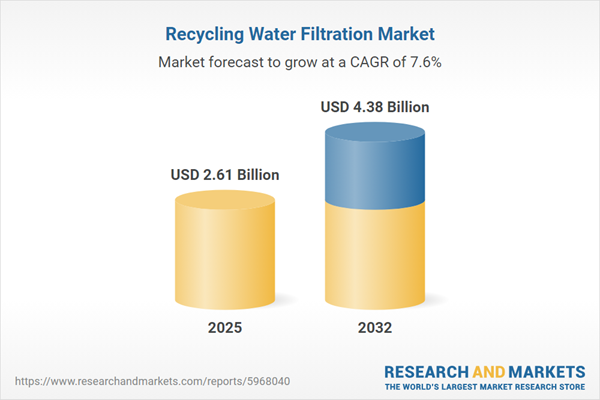Speak directly to the analyst to clarify any post sales queries you may have.
As global industries confront tightening sustainability mandates, the recycling water filtration market is emerging as a key enabler of resource optimization, compliance, and operational resilience for organizations of all sizes.
Market Snapshot: Recycling Water Filtration Market Growth and Dynamics
The Recycling Water Filtration Market grew from USD 2.44 billion in 2024 to USD 2.61 billion in 2025 and is projected to achieve a CAGR of 7.57%, reaching USD 4.38 billion by 2032.
Scope & Segmentation
- Product Offerings: Activated carbon adsorption excels at removing organic contaminants, filtration systems offer modular scalability, and membrane bioreactors combine biological treatment with advanced filtration.
- Membrane Types: Microfiltration targets coarse particulates, nanofiltration addresses specific ions and organics, reverse osmosis delivers high purity, and ultrafiltration balances operational efficiency with cost.
- Water Sources: Groundwater, seawater, and surface water each present unique treatment needs involving varying levels of iron, organics, salinity, and turbidity.
- Applications: Covered areas include agricultural irrigation, desalination, power generation, recreational water facilities, and wastewater treatment, reflecting a broad scope of deployment scenarios.
- End-User Verticals: The analysis spans commercial, industrial, and residential sectors, each seeking filtration solutions tailored to their operational and compliance requirements.
- Regional Focus: In-depth market coverage includes the Americas, Europe, Middle East & Africa, and Asia-Pacific, with expanded insights into countries such as the United States, Canada, Germany, China, and Australia.
- Company Developments: Profiles of established leaders and innovative entrants—such as Amiad Water Systems Ltd., Danaher Corporation, SUEZ SA, Veolia Environnement S.A., and Xylem Inc.—highlight recent product launches and strategic moves across global markets.
Key Takeaways for Senior Decision-Makers
- Recycling water filtration technologies are evolving due to growing regulatory scrutiny, advances in membrane science, and the integration of digital monitoring tools that boost system efficiency.
- Rapidly changing environmental policies are compelling enterprises to validate water recovery processes in real-world, high-complexity industrial and municipal settings.
- Adopting innovative filtration modules, such as hybrid membrane-biological systems, positions organizations to meet emerging performance benchmarks and compliance targets.
- Cross-sector collaborations—including partnerships with research institutions and public agencies—are driving the development and deployment of next-generation filtration solutions.
- Supply chain resilience is heightened by recent tariff actions; organizations are reassessing vendor strategies and considering near-shoring or local innovation to ensure continuity and cost control.
Tariff Impact: Navigating Changing Cost Structures and Supply Strategies
The 2025 United States tariff adjustments targeting membrane imports and filtration components have increased complexity for procurement, pricing, and sourcing across the recycling water filtration value chain. As a result, supply teams are pursuing alternative supplier networks, evaluating regional manufacturing, and accelerating proprietary component development to reduce exposure and bolster system reliability. This shift opens the market to domestic innovators and prompts new collaborations focused on at-scale, locally compliant solutions.
Methodology & Data Sources
This study employs a rigorous approach by combining in-depth executive interviews, technical expert discussions, and regulatory reviews with secondary research from trade publications, government sources, and peer-reviewed literature. Analysis is further validated through independent expert panels, comprehensive data synthesis, and multi-stage fact-checking to ensure all findings are unbiased and actionable.
Why This Report Matters for Industry Leaders
- Empowers senior executives with actionable intelligence on market drivers, risk mitigation strategies, and emerging regional investment priorities.
- Enables strategic planning by illuminating the impact of regulatory, technological, and supply chain shifts on filtration solution adoption and procurement.
- Supports competitive positioning with exclusive insights into segmentation trends, collaborative ventures, and R&D focus among leading global firms.
Conclusion
Recycling water filtration stands at the intersection of sustainability, compliance, and operational excellence. Senior decision-makers who proactively align with these evolving market dynamics are positioned to capitalize on both short- and long-term value creation opportunities.
Additional Product Information:
- Purchase of this report includes 1 year online access with quarterly updates.
- This report can be updated on request. Please contact our Customer Experience team using the Ask a Question widget on our website.
Table of Contents
3. Executive Summary
4. Market Overview
7. Cumulative Impact of Artificial Intelligence 2025
Companies Mentioned
The companies profiled in this Recycling Water Filtration market report include:- Amiad Water Systems Ltd.
- AquaRecycle
- AquaSafe Water Filters
- Danaher Corporation
- DROP Products and Services
- Ecolab Inc
- EnviroWater Group
- Epic Cleantec Inc
- European WaterCare Ltd.
- Forsta Filters Inc.
- Hydraloop Systems BV
- Hydro Engineering, Inc.
- INTEWA GmbH
- Koch Membrane Systems, Inc.
- KUBOTA Corporation
- Kurita Water Industries Ltd.
- Napa Recycling and Waste Services
- Pentair plc
- Select Water Solutions, Inc.
- SUEZ SA
- TerraCycle UK Ltd.
- Toray Industries, Inc.
- Toshiba Corporation
- Veolia Environnement S.A.
- Xylem Inc.
Table Information
| Report Attribute | Details |
|---|---|
| No. of Pages | 181 |
| Published | November 2025 |
| Forecast Period | 2025 - 2032 |
| Estimated Market Value ( USD | $ 2.61 Billion |
| Forecasted Market Value ( USD | $ 4.38 Billion |
| Compound Annual Growth Rate | 7.5% |
| Regions Covered | Global |
| No. of Companies Mentioned | 26 |









